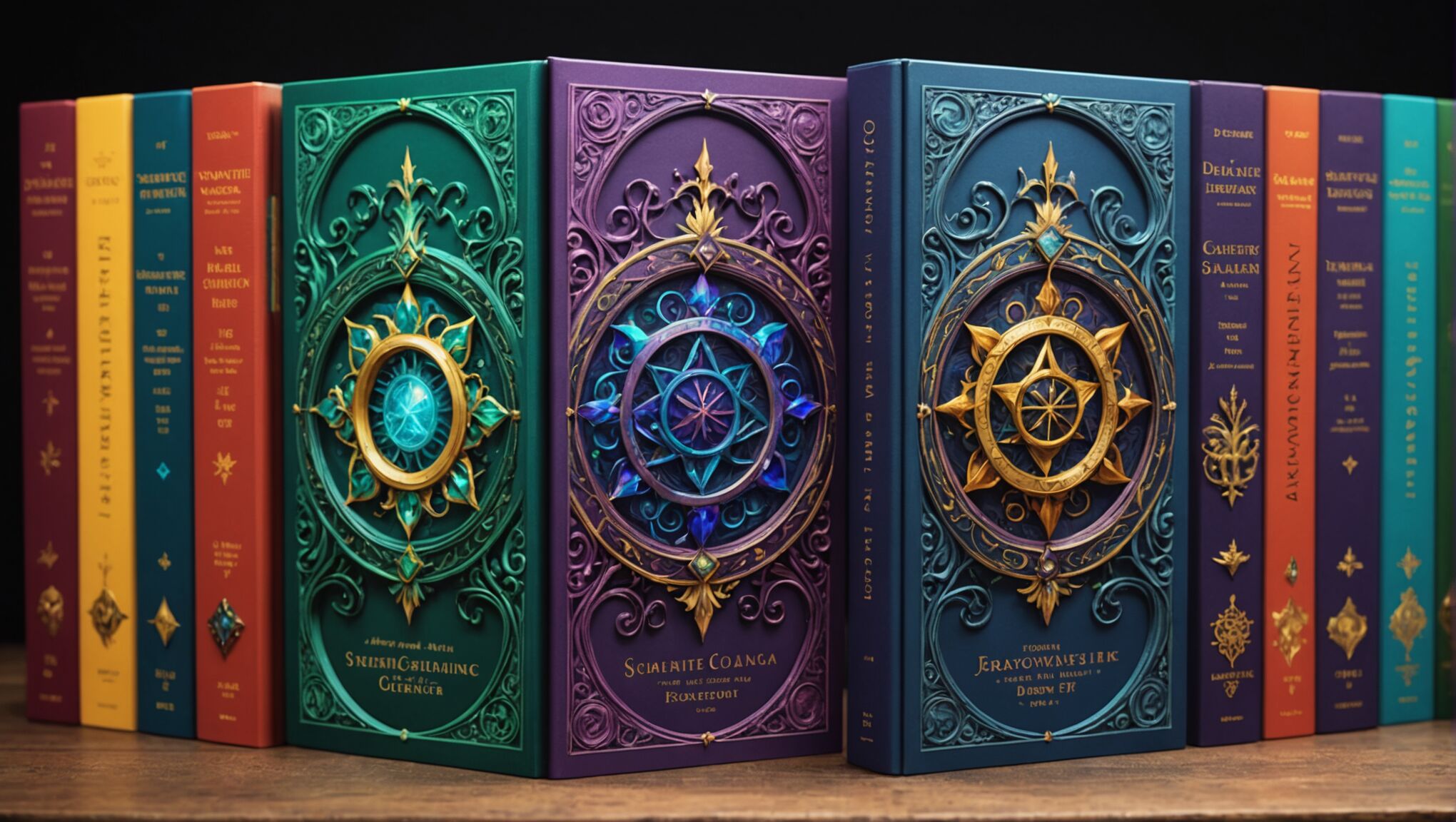blog
Designing Fantasy Covers for Series: Consistency is Key
Color palette selection and maintenance
 Selecting an appropriate color palette for a fantasy book series is crucial in establishing a visual identity that readers can instantly recognize. A well-chosen color scheme not only sets the tone for the entire series but also helps to differentiate it from other works in the genre. When selecting colors, consider the overall mood and themes of the series. For example, a dark fantasy might utilize deep purples, blacks, and blood reds, while a whimsical fairy tale-inspired series could incorporate softer pastels or vibrant jewel tones.
Selecting an appropriate color palette for a fantasy book series is crucial in establishing a visual identity that readers can instantly recognize. A well-chosen color scheme not only sets the tone for the entire series but also helps to differentiate it from other works in the genre. When selecting colors, consider the overall mood and themes of the series. For example, a dark fantasy might utilize deep purples, blacks, and blood reds, while a whimsical fairy tale-inspired series could incorporate softer pastels or vibrant jewel tones.
Once a color palette is established, it’s essential to maintain consistency throughout the series. This doesn’t mean every cover should be identical, but rather that the chosen colors should be present in some form on each book. Designers can achieve this by using the same background color, incorporating consistent color accents, or maintaining a specific color ratio across all covers.
“Color is a power which directly influences the soul.” – Wassily Kandinsky
It’s also important to consider how colors will evolve or shift as the series progresses. This can be done subtly, such as gradually lightening or darkening the palette to reflect the story’s progression. For instance, a series that begins in a time of darkness and moves towards hope could start with predominantly dark hues and gradually introduce brighter colors in later volumes.
When working with color, designers should also take into account how the covers will appear both individually and as a set. The colors should complement each other when the books are displayed side by side, creating a cohesive visual narrative. Additionally, consider how the chosen palette will translate to different formats, such as e-book thumbnails or promotional materials, to ensure the series remains recognizable across various platforms.
Lastly, it’s crucial to test the color palette in different lighting conditions and on various devices to ensure readability and visual appeal. Colors can appear differently on screens compared to print, so designers should account for these variations to maintain consistency across all mediums.
Typography and font choices across volumes

The typography and font choices for a fantasy series are pivotal in creating a distinct visual identity and maintaining consistency across volumes. The selected fonts should not only be visually appealing but also reflect the tone and atmosphere of the series. For instance, an epic high fantasy might benefit from elegant, serif fonts that evoke a sense of timelessness, while a modern urban fantasy could utilize sleek, sans-serif typefaces to convey a contemporary feel.
Consistency in font usage is crucial for brand recognition. The title font should remain constant throughout the series, acting as a visual anchor for readers. This doesn’t mean the font can’t evolve slightly; subtle variations in size, color, or effects can be employed to reflect the progression of the story or changes in tone, but the core typeface should remain identifiable.
It’s also important to consider the hierarchy of text elements on the cover. The author’s name and series title, if applicable, should have a consistent placement and styling across all volumes. This helps readers quickly identify new releases in the series and reinforces the author’s brand.
When selecting fonts, designers should ensure they are legible at various sizes, from large-scale prints to small thumbnails on online bookstores. This is particularly important for fantasy titles, which often feature intricate or stylized fonts that may become illegible when reduced in size.
Learn how typography shapes reader interest. Check it out.
Additionally, the interplay between different fonts on the cover should be harmonious. If using multiple typefaces, they should complement each other while maintaining a clear hierarchy. Typically, limiting the number of fonts to two or three creates a more cohesive look.
Font licensing is another crucial consideration. Designers must ensure they have the appropriate rights to use the chosen fonts across all books in the series and in various marketing materials. Custom fonts or modified existing typefaces can be an excellent way to create a unique look for the series while avoiding licensing issues.
The typography should work in tandem with other design elements on the cover. It should complement the artwork, color palette, and overall composition without overwhelming or detracting from the visual impact. The goal is to create a harmonious balance where text and imagery work together to capture the essence of the fantasy world within the pages.
Recurring symbols and motifs
Incorporating recurring symbols and motifs into fantasy book covers is a powerful way to create visual continuity and reinforce the series’ themes. These elements serve as visual anchors, instantly connecting each new release to its predecessors and evoking the essence of the fantasy world.
When selecting symbols or motifs, consider key elements from the story that are central to the plot, character development, or the fantasy world itself. These could be magical artifacts, mythical creatures, specific landscapes, or abstract representations of important concepts. For example, a series focused on elemental magic might feature stylized icons representing fire, water, earth, and air on each cover.
Consistency in the representation of these symbols is crucial. While the exact depiction may evolve slightly from book to book, the core design should remain recognizable. This evolution can be used to reflect the progression of the story or changes in the characters’ relationships to these elements.
| Symbol Type | Example | Purpose |
| Magical Objects | A glowing amulet | Represents a key plot device |
| Creatures | A dragon silhouette | Indicates the presence of mythical beings |
| Natural Elements | A stylized tree | Symbolizes the importance of nature in the story |
The placement of these symbols on the cover is also important. They can be integrated into the main artwork, used as framing devices, or incorporated into the typography. Consistency in placement across volumes helps readers quickly identify the series, even if other elements of the cover design change.
Consider how these symbols can be used to create a visual narrative across the series. For instance, a symbol that appears small and insignificant on the first book cover might grow in size or prominence in subsequent volumes, mirroring its increasing importance in the story.
The style in which these motifs are rendered should align with the overall aesthetic of the series. A gritty, realistic fantasy might feature detailed, textured symbols, while a more whimsical series could use simplified, iconic representations.
Color can play a crucial role in how these symbols are perceived. Using consistent colors for specific motifs across the series can help reinforce their significance and create a cohesive look. However, subtle color shifts can also be employed to show change or progression.
It’s important to strike a balance between repetition and variation. While the recurring symbols should be present on each cover, their presentation can be altered to keep each book fresh and intriguing. This could involve changing the size, orientation, or surrounding elements while maintaining the core design.
Consider how these symbols might be used beyond the book covers. They can be incorporated into chapter headings, used on promotional materials, or even developed into merchandise. This extended use helps to build a strong visual brand for the series.
Lastly, ensure that the chosen symbols and motifs remain relevant throughout the series. If certain elements lose significance as the story progresses, consider phasing them out or replacing them with new motifs that better represent the evolving narrative.
Character representation and evolution
 As the fantasy series progresses, characters often undergo significant development and transformation. This evolution should be reflected in their representation on the book covers, providing visual cues to readers about the journey they’re about to embark upon or continue.
As the fantasy series progresses, characters often undergo significant development and transformation. This evolution should be reflected in their representation on the book covers, providing visual cues to readers about the journey they’re about to embark upon or continue.
When depicting characters across multiple volumes, it’s crucial to maintain a consistent core appearance while subtly altering elements to show growth or change. This might involve adjusting the character’s posture, expression, or attire to reflect their emotional state or status in each installment. For instance, a protagonist who starts as an unsure novice might be portrayed with a hesitant stance on the first cover, gradually adopting more confident poses in subsequent books.
The art style used for character representation should remain consistent throughout the series, even if different artists are involved. This can be achieved by establishing clear guidelines for character design, including details like facial features, body proportions, and signature accessories or weapons. These guidelines ensure that characters remain recognizable across volumes, regardless of who is creating the artwork.
Consider the symbolism in how characters are positioned on the cover. A character who begins in the background of the first book’s cover might move to the forefront in later volumes, visually representing their increasing importance to the story. Conversely, characters who diminish in significance might be depicted smaller or further in the background as the series progresses.
The interaction between characters on the covers can also evolve to reflect changing relationships within the story. Allies might be shown closer together, while growing conflicts could be represented by increasing distance or oppositional positioning between characters.
It’s important to be mindful of spoilers when representing character evolution on covers. While subtle changes can hint at character development, drastic alterations might reveal too much about the plot. Designers must strike a balance between intriguing readers and preserving the story’s surprises.
For series with large casts, consider rotating the focus on different characters for each book while maintaining a consistent style. This approach allows for showcasing various characters while keeping the overall series design cohesive.
The use of color in character depiction can also signify growth or change. A character’s color palette might shift subtly to reflect their emotional journey or align with new allegiances or powers they acquire throughout the series.
When depicting magical or supernatural elements associated with characters, ensure these evolve in tandem with the character’s development. For example, a wizard’s magical aura might grow more complex or intense as their powers increase throughout the series.
Finally, consider how the character representations will translate across different formats, from hardcover editions to e-book thumbnails. Ensure that the key elements of character evolution are discernible even in smaller formats to maintain the visual narrative across all platforms.
Balancing uniqueness and cohesion in each cover

While maintaining consistency across a fantasy book series is crucial, it’s equally important to ensure that each cover stands out as a unique and compelling piece of art. Striking this balance between cohesion and individuality is a delicate process that requires careful consideration and creativity.
One effective approach is to establish a consistent layout or framework for the series, but allow for variation within that structure. For example, you might maintain a consistent position for the title and author name, but change the central image or background for each book. This provides a familiar structure for readers while offering fresh visual interest with each new release.
Varying the focal point of each cover can also help achieve this balance. While keeping consistent elements like color palette and typography, you can shift the emphasis from a character in one book to a landscape in another, or from an action scene to a symbolic object. This variation keeps the series visually engaging while still feeling part of a cohesive whole.
Another technique is to use a unifying element that evolves or changes slightly with each book. This could be a central symbol that transforms or gains new details, or a background element that progressively changes to reflect the story’s progression. This approach creates a visual narrative across the series while giving each cover its own identity.
Color can be a powerful tool in balancing uniqueness and cohesion. While maintaining a consistent overall palette, you can emphasize different colors for each book. This might involve shifting the dominant color or introducing new accent colors that complement the established scheme. Such variations can reflect the tone or themes of each individual book while still feeling part of the larger series.
Incorporating unique textures or patterns into each cover, while keeping other elements consistent, is another way to differentiate volumes. This could involve varying the treatment of the background or introducing distinctive visual elements that relate to the specific story in each book.
For series with recurring characters, consider showing different aspects or moments for each book. This could mean featuring different characters prominently or showing the same character in various situations or emotional states, providing both continuity and freshness.
It’s also worth considering how the covers will look side by side. Design elements that create interesting interactions or patterns when the books are displayed together can add an extra layer of cohesion to the series while allowing each cover to stand alone effectively.
Ultimately, the key to balancing uniqueness and cohesion lies in careful planning and a clear understanding of the series’ overall visual strategy. By establishing strong guidelines for consistent elements while allowing for creative variation in others, designers can create covers that are both individually striking and collectively harmonious, enhancing the appeal of the entire fantasy series.
